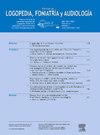6 - 8岁儿童咀嚼硬食物和关节精准度:初步结果
Q3 Nursing
引用次数: 0
摘要
发音精度(articatory precision, AP)是指语音结构达到预期目标的准确性。在典型的发育中,可能有轻微的发音不精确。这方面的研究有限,AP的发展仍不清楚。材料和方法本研究考察了固体食物的引入、对硬固体和牛肉的咀嚼能力(MA)、对硬食物的回避行为和AP之间的关系。研究对象为42名年龄在6 - 8岁之间的典型发育中的西班牙语儿童。通过家庭访谈收集参与者的食物史和与食物硬度相关的行为信息,并对AP进行感知评估。结果食物史、咀嚼技能和回避行为与食物硬度之间存在显著相关性。研究还发现,对于有AP的牛肉,食物的引入与MA之间也存在显著的关系。在硬固体的MA、回避行为和AP之间没有发现显著的关联。结论:延迟食物引入的参与者表现出较差的MA和更大的对硬食物的排斥。结果表明,咀嚼肉类时的MA与AP之间存在关联,即咀嚼肉类能力较低的个体PA较差。结果是探索性的;需要进一步的研究来补充它们。本文章由计算机程序翻译,如有差异,请以英文原文为准。
Masticación de alimentos duros y precisión articulatoria en niños de 6 a 8 años: resultados preliminares
Background
Articulatory precision (AP) refers to the accuracy with which the speech structures achieve their intended goals. In typical development there may be slight articulatory imprecision. Studies on this subject are limited, and the development of AP remains unclear. We aimed to investigate whether there is an association between the hardness of the foods consumed and the development of AP.
Materials and methods
This study examined the relationship between the introduction of solid foods, masticatory ability (MA) for hard solids and beef, avoidant behaviors toward hard foods, and AP. Forty-two typically developing Spanish-speaking children, aged between 6 and 8 years, participated. Family interviews were conducted to gather information about the participants’ food history and behaviors related to food hardness, and AP was assessed perceptually.
Results
Significant associations were found between food history, masticatory skills, and avoidant behaviors related to food hardness. A significant relationship was also observed between the introduction of food and MA for beef with AP. No significant associations were found between MA for hard solids, avoidant behaviors, and AP.
Conclusions
Participants with delayed food introduction present poorer MA and greater rejection of hard foods. The results suggest an association between MA when chewing meat and AP, that is, individuals with lower ability to chew meat show poorer PA. The results are exploratory; further studies are needed to complement them.
求助全文
通过发布文献求助,成功后即可免费获取论文全文。
去求助
来源期刊

Revista de Logopedia, Foniatria y Audiologia
Nursing-LPN and LVN
CiteScore
1.10
自引率
0.00%
发文量
28
 求助内容:
求助内容: 应助结果提醒方式:
应助结果提醒方式:


